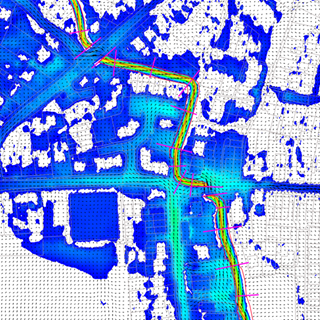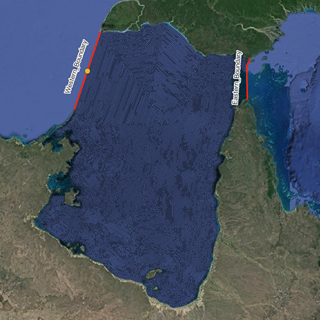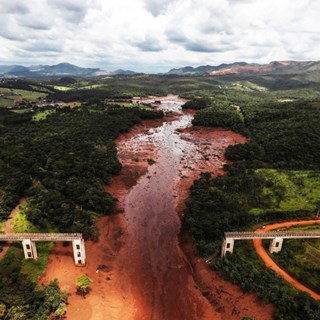11 May 2025
TUFLOW CATCH is an add-on module for both TUFLOW HPC and TUFLOW FV. In simple terms it:
This added functionality unlocks a truly unique assessment tool for catchment to coast environmental water quantity and quality assessment. TUFLOW CATCH is different to other products in the market. It supports detailed bottom-up holistic environmental assessment at whole of catchment scale by seamlessly integrating catchment surface and subsurface hydraulic, pollutant export and receiving water numerical models without the need for traditional top-down average (lumped) assumptions. TUFLOW CATCH solves the equations of motion and transport on a high-resolution cell-by-cell basis and temporal resolution. This allows simulation of environmental processes as and where they actually occur on ground, and in associated waterways. Multi-annual simulation is achieved by exploiting the modern compute power of GPU acceleration, a technology that TUFLOW has been a world leader in for over a decade.
TUFLOW CATCH is the first of its kind. Compared against contemporary alternatives, its bottom-up approach represents a step change in environmental simulation performance and accuracy. It enables environmental managers and decision makers with the tools necessary to make informed decisions based on a true representation of the natural processes that influence and drive water quality behaviour in the catchment and its waterways. The significance of this is highlighted by the recent industry awards TUFLOW CATCH has recently won, including:
The following video provides a project demonstration of TUFLOW CATCH.
It is common practice to design and implement surface water quality treatment devices across catchments. This aspect of TUFLOW CATCH is presented. It allows for the seamless simulation of the whole of system benefits and performance of these devices at high temporally and spatially resolved scales. A case study is shared to demonstrate this capability.
Pollutants exported from an upstream catchment often dominate the overall pollutant load delivered to receiving water environments. Accurate representation of catchment pollutant export is therefore crucial to support robust receiving water quality modelling analyses. Unfortunately, spatially and temporally lumped hydrologic models typically estimate this important pollutant export by multiplicatively applying static event mean and dry weather concentrations (EMC and DWC, respectively) at bottom of catchment to co-temporal lumped hydrologic volume predictions. These approaches often do not have a direct connection with physical processes or their associated numerical solution representations, but instead attempt to draw on historical averages of concentration based observations made downstream of various land uses. These methods also do not apply to speciated pollutants, but rather, consider total nutrients alone and rely on receiving water model users to post-hoc split these total predictions into constituents. The limitations of these historic approaches are potentially significant.
TUFLOW CATCH is a fundamental shift in the way that simulation of pollutant export from catchments has historically been undertaken. In this new approach, EMCs or DWCs are no longer multiplicatively applied to lumped hydrology to compute mass loads: rather, an approach has been taken to allow simulation of processes as they occur on the ground – not through application of averages. This paradigm shift means that:
Together with the improved flow prediction methods using direct rainfall hydrology (instead of lumped hydrologic), these pollutant export methods coupled with the spatially distributed discretisation of model inputs and assessment results, provide catchment managers with the opportunity to assess intervention options in new ways. It creates a framework to support user friendly assessment of site specific land use or catchment changes, and their subsequent impact on receiving waterway hydrodynamics and water quality. Example applications include impact and mitigation assessment for catchment scale land use planning, urban development water quality assessment, road runoff water quality, catchment sediment runoff and streambank gully erosion, nutrient offset trading and more.
Interested in learning more? Please see the following links for technical content:
TUFLOW CATCH Pilot Study Report (Queensland Water Modelling Network and Queensland Healthy Land and Water)
Australian Water School Webinars
Interactive User Documentation
Free TUFLOW CATCH Tutorials and Demonstration Models
Contact TUFLOW
Email info@tuflow.com to schedule a call to speak with a TUFLOW representative.

TUFLOW - Info
The Pix Brook Flood Study is a multi-stakeholder options and feasibility investigation needing an integrated catchment wide model. TUFLOW was chosen due to its ability to represent surface water, fluvial and pipe networks within the one modelling software.

TUFLOW - Info
To solve environmental problems in our rivers, lakes, estuaries and coastal waters, hydrodynamic models rely on a range of boundary condition forcings. For a complex model, there may be hundreds of necessary boundary conditions, each requiring input data for multiple parameters.

TUFLOW - Info
Modelling the 2019 Brumadinho Tailings Dam Failure with TUFLOW HPC's Non-Newtonian Fluid Functionality

TUFLOW - Info
Although there isn't a new TUFLOW release in time for Christmas, that does not mean there aren't any TUFLOW goodies to sink your teeth in to in the New Year.